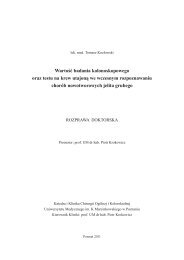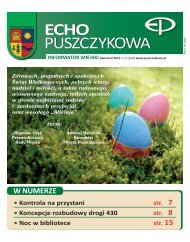MILITARY PHARMACY AND MEDICINE
MILITARY PHARMACY AND MEDICINE
MILITARY PHARMACY AND MEDICINE
You also want an ePaper? Increase the reach of your titles
YUMPU automatically turns print PDFs into web optimized ePapers that Google loves.
© Military Pharmacy and Medicine • 2012 • 4 • 2 – 16therapeutic approach focuses on prophylaxis inthe form of properly profiled diet and the intakeof dietary supplements. The number of these supplementsis constantly growing, and all of themare freely available, i.e. without prescription. Theavailable supplements differ in both qualitativeand quantitative composition. A detailed analysisof supplements available at Polish marketas described by the author in 2010 in an articleentitled Ophthalmic antioxidant preparations:a survey and supportive arguments for their usein AMD [2], included 73 products — all of themcontained the macular pigment — lutein, somecontained also zeaxanthin, and only one containedthree macular pigments, namely lutein,zeaxanthin and meso-zeaxanthin.Currently nearly 100 ophthalmic antioxidantpreparations are available only at Polish market.This does not include numerous preparationscontaining polyunsaturated fatty acidsof the omega-3 series (PUFA-ω3), discussed bythe author in his earlier study entitled Omega-3polyunsaturated fatty acids in retina and medicalpractice — pros and cons [3]. Ophthalmologists,as well as patients, may have and, according toauthor’s knowledge, indeed have problems withchoosing an appropriate preparation. However,resorting to dietary supplement may be perhapsunnecessary if appropriate choice of foodproducts is made for one’s everyday diet. Theauthor hopes that this study, confronting thedietary and supplementation aspects of prophylaxiswill contribute to appreciation of the role ofeveryday diet rich in selected products in AMDprophylaxis and acknowledging the value of suchdiet as not inferior to that of pharmaceuticalsupplementation.AMD – origin and developmentof the pathologyAge-related macular degeneration (AMD) developsinconspicuously over many years. Despitenumerous studies conducted worldwide, thepathogenesis of the disease is not fully understood.Due to the plurality of factors, both endogenous(e.g. genetic predispositions) and exogenous(history of exposure to light) or behavioral(e.g. smoking, improper diet), which might predispose,or even contribute to the developmentof the disease, the critical physiological processesresponsible for the vision process (e.g. the visualReview articleexcitation cascade) move beyond the limits ofhomeostasis, creating a biochemical platform forthe future pathology [4–9]. This involves intensifiedlipofuscinogenesis in retinal pigment epithelium(RPE) cells, formation of drusen andpseudodrusen — the former occurring under theRPE monolayer (i.e. in the direction of Bruch’smembrane), the latter above the RPE monolayer(i.e. towards photoreceptors) and next, a chronicinflammatory process known as para-inflammation.All these phenomena contribute to thedevelopment of AMD. Clinically, AMD can bedivided into the dry, or atrophic, form (knownas geographic atrophy), and wet — exudative, orneovascular form; the latter can be considered acomplication of the atrophic form manifesting aschoroidal neovascularization (CNV) [1,4,5].Aging favors the development of AMD, particularlyin predisposed individuals (due to concomitantpresence of the risk factors listed above); theterm “age-related” in the disease name – AMD isfully justified, as the age is the major (albeit individual,i.e. specific to each subject) and unavoidabledeterminant of various dysfunctions at thecellular and organ level, including these associatedwith the deficiency of necessary microelements/nutrientsor with the loss of function inthe aging cells — particularly post-mitotic, i.e.non-regenerable cells. While the lacking microelements/nutrientsmay be supplied from theoutside, thus attempting to compensate for theirdeficiency in particular cells/tissues, we are unableuntil now to stop the systemic aging process.Our bodies contain many non-regenerable (postmitotic)cells, particularly within the centralnervous system. These include the photoreceptors(only the external segments that containphotopigments are subject to regeneration) andretinal pigment epithelium (RPE) cells. In thepathogenesis of AMD, RPE cells are the first cellsthat become metabolically inefficient and thusundergo degeneration; dysfunction and atrophyof photoreceptors is secondary, as they are unableto function and survive without functionallyefficient RPE cells, and therefore also undergodegeneration. The pathological process involvesmostly a small region of the retina, known asthe macula, where cone photoreceptors, responsiblefor acute and color vision, are predominant.Therefore, first clinical symptoms of AMDinclude blurred vision, defects of central vision of2 http://military.isl-journals.com
















